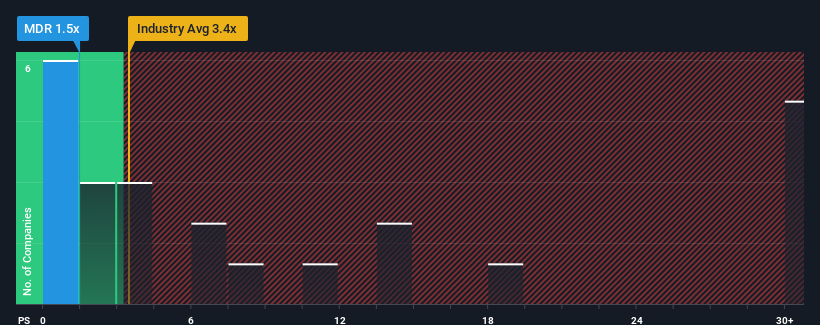- Australia
- /
- Healthtech
- /
- ASX:MDR
Why Investors Shouldn't Be Surprised By MedAdvisor Limited's (ASX:MDR) Low P/S
MedAdvisor Limited's (ASX:MDR) price-to-sales (or "P/S") ratio of 1.5x might make it look like a strong buy right now compared to the Healthcare Services industry in Australia, where around half of the companies have P/S ratios above 5.9x and even P/S above 18x are quite common. However, the P/S might be quite low for a reason and it requires further investigation to determine if it's justified.
Check out our latest analysis for MedAdvisor

What Does MedAdvisor's P/S Mean For Shareholders?
MedAdvisor could be doing better as it's been growing revenue less than most other companies lately. Perhaps the market is expecting the current trend of poor revenue growth to continue, which has kept the P/S suppressed. If you still like the company, you'd be hoping revenue doesn't get any worse and that you could pick up some stock while it's out of favour.
Want the full picture on analyst estimates for the company? Then our free report on MedAdvisor will help you uncover what's on the horizon.How Is MedAdvisor's Revenue Growth Trending?
The only time you'd be truly comfortable seeing a P/S as depressed as MedAdvisor's is when the company's growth is on track to lag the industry decidedly.
Retrospectively, the last year delivered an exceptional 17% gain to the company's top line. This great performance means it was also able to deliver immense revenue growth over the last three years. So we can start by confirming that the company has done a tremendous job of growing revenue over that time.
Turning to the outlook, the next year should generate growth of 15% as estimated by the three analysts watching the company. With the industry predicted to deliver 58% growth, the company is positioned for a weaker revenue result.
With this information, we can see why MedAdvisor is trading at a P/S lower than the industry. It seems most investors are expecting to see limited future growth and are only willing to pay a reduced amount for the stock.
What We Can Learn From MedAdvisor's P/S?
We'd say the price-to-sales ratio's power isn't primarily as a valuation instrument but rather to gauge current investor sentiment and future expectations.
As expected, our analysis of MedAdvisor's analyst forecasts confirms that the company's underwhelming revenue outlook is a major contributor to its low P/S. Shareholders' pessimism on the revenue prospects for the company seems to be the main contributor to the depressed P/S. The company will need a change of fortune to justify the P/S rising higher in the future.
A lot of potential risks can sit within a company's balance sheet. You can assess many of the main risks through our free balance sheet analysis for MedAdvisor with six simple checks.
It's important to make sure you look for a great company, not just the first idea you come across. So if growing profitability aligns with your idea of a great company, take a peek at this free list of interesting companies with strong recent earnings growth (and a low P/E).
New: Manage All Your Stock Portfolios in One Place
We've created the ultimate portfolio companion for stock investors, and it's free.
• Connect an unlimited number of Portfolios and see your total in one currency
• Be alerted to new Warning Signs or Risks via email or mobile
• Track the Fair Value of your stocks
Have feedback on this article? Concerned about the content? Get in touch with us directly. Alternatively, email editorial-team (at) simplywallst.com.
This article by Simply Wall St is general in nature. We provide commentary based on historical data and analyst forecasts only using an unbiased methodology and our articles are not intended to be financial advice. It does not constitute a recommendation to buy or sell any stock, and does not take account of your objectives, or your financial situation. We aim to bring you long-term focused analysis driven by fundamental data. Note that our analysis may not factor in the latest price-sensitive company announcements or qualitative material. Simply Wall St has no position in any stocks mentioned.
About ASX:MDR
Adheris Health
Provides pharmacy-driven patient engagement solutions in Australia, the United States, and the United Kingdom.
High growth potential and good value.
Market Insights
Community Narratives


Recently Updated Narratives


MINISO's fair value is projected at 26.69 with an anticipated PE ratio shift of 20x


Fiverr International will transform the freelance industry with AI-powered growth

Constellation Energy Dividends and Growth
Popular Narratives


MicroVision will explode future revenue by 380.37% with a vision towards success


NVDA: Expanding AI Demand Will Drive Major Data Center Investments Through 2026



